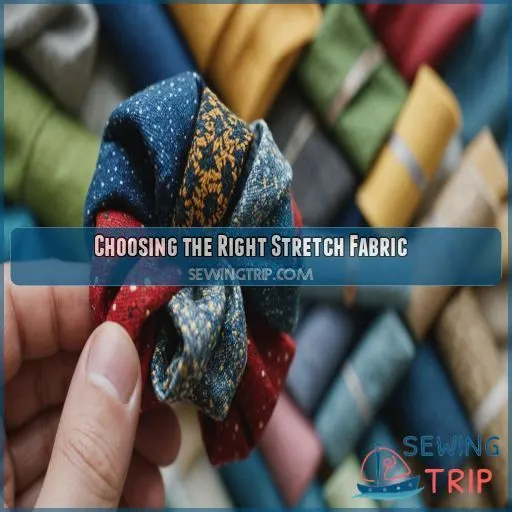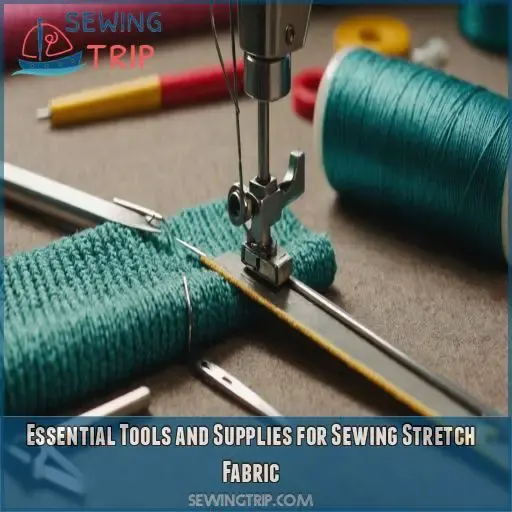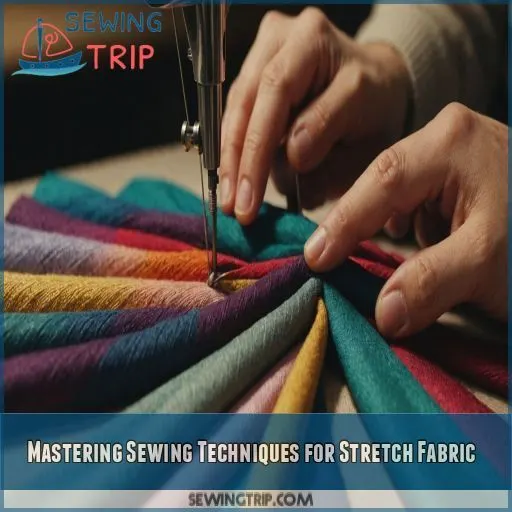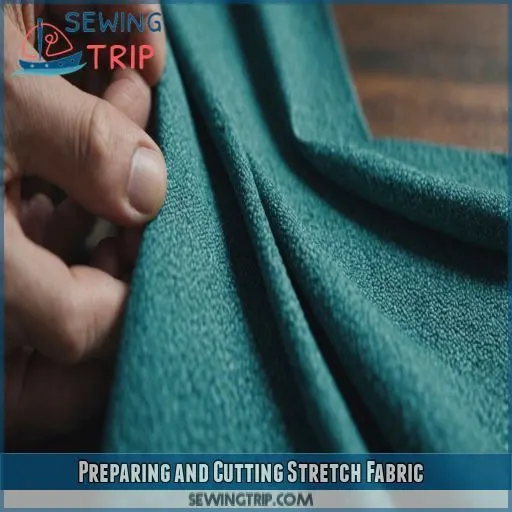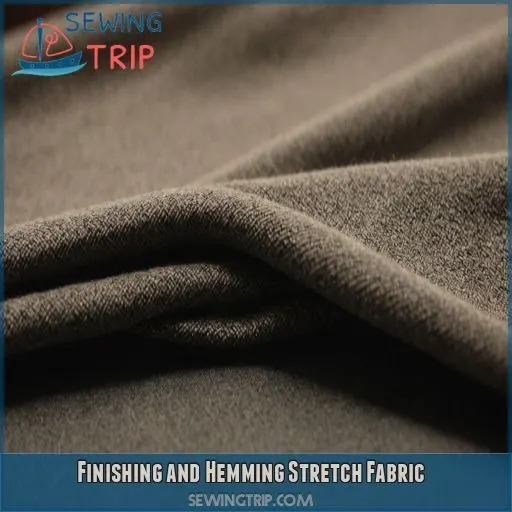This site is supported by our readers. We may earn a commission, at no cost to you, if you purchase through links.
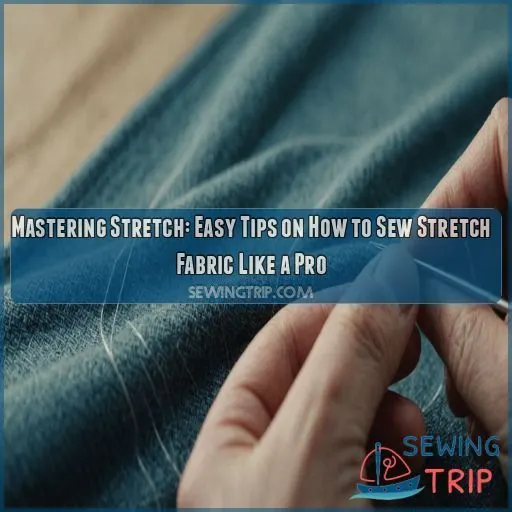 Don’t worry, friend, sewing stretch fabric isn’t as scary as it seems.
Don’t worry, friend, sewing stretch fabric isn’t as scary as it seems.
First, choose the right fabric for your project – think jersey for a flowy sundress or heavy double knit for active wear.
When cutting, remember that knit fabric’s grain direction is parallel to the selvage, and stretch direction is crosswise.
To prevent curling edges, opt for fabrics with a bit of weight and a smooth texture.
Now, grab your ballpoint needle and polyester thread, and get ready to master the art of sewing stretch fabric like a pro!
Your comfortable, flexible garments await.
Table Of Contents
Key Takeaways
- Mastering the art of sewing stretch fabric is all about confidence – don’t let it intimidate you! Start by choosing the right fabric for your project, whether that’s a flowy jersey for a sundress or a heavy double knit for activewear. Think of it like baking a cake: you need to pick the right ingredients to get the perfect result.
- When working with stretch fabrics, it’s super important to identify the grain line and stretch direction. Don’t worry if it seems like a puzzle at first – just check the label or do a simple stretch test to figure it out. And remember, aligning your pattern pieces correctly is the key to a professional finish.
- Pressing your seams gently is crucial to prevent distortion. Think of it like handling a delicate flower – you want to be gentle, not rough. Use a low heat setting, a pressing tool, and a light touch to get the job done. And don’t forget to maintain that seam allowance, or you might end up with a wonky finish.
- Don’t be a rookie – buy extra fabric for errors! Trust us, you’ll thank us later. It’s better to be safe than sorry, especially when working with stretchy materials. Plus, having some extra fabric on hand can be a lifesaver if you need to make adjustments or fix mistakes. Happy sewing!
Choosing the Right Stretch Fabric
When you’re sewing with stretch fabrics, choosing the right material can really make or break your project – you want something that feels great and lasts! To get the most out of your sewing, let’s figure out how to pick the perfect stretch fabric for your needs, whether you’re making a comfy t-shirt or a sleek pair of leggings.
Identifying Types of Stretch Fabric
To master stretch fabrics, you need to know what you’re working with. Identifying the type of stretch fabric is key. You’ve got three main types to think about:
- Woven stretch fabrics: Containing a small percentage of elastic fibers like elastane.
- Knit stretch fabrics: Created by interlocking loops of stitches, giving natural stretch.
- Jersey fabrics: A common type of knit fabric, perfect for t-shirts and dresses.
Don’t worry, it’s easier than it sounds!
Considering Weight and Stretch
When choosing stretch fabric, you’ll want to think about weight and stretch. Think of it like baking – too little or too much of either ingredient can ruin the final product. For example, a lightweight single knit with 2-way stretch is perfect for a flowy sundress, while a heavier double knit with 4-way stretch is better suited for active wear.
| Fabric Weight | Stretch Level | Garment Fit |
|---|---|---|
| Lightweight | 2-way stretch | Loose, flowy |
| Medium weight | 2-3 way stretch | Fitted, but not tight |
| Heavy weight | 4-way stretch | Tight, compressive |
| Single knit | Low-moderate stretch | Dresses, tops |
| Double knit | High stretch | Active wear, swimwear |
Looking for Fabrics That Don’t Curl at the Edges
Don’t let it ruin your stretch fabric projects. When shopping for fabrics, look for ones that lie flat and don’t curl at the edges. This makes sewing a breeze, especially for beginners. Here are some tips to keep in mind:
- Opt for jersey fabrics, which tend to have a smooth, flat edge.
- Avoid fabrics with loose weaves or uneven textures, as they’re more prone to curling.
- Choose fabrics with a bit of weight to them, as they’re less likely to curl up or fray.
Paying Attention to the Direction of Stretch
Now that you’ve found a fabric that doesn’t curl at the edges, let’s talk direction. When working with stretch fabrics, it’s really important to identify the grain line and stretch direction. Check your fabric’s label or perform a simple stretch test to determine the direction of stretch.
| Fabric Type | Grain Direction | Stretch Direction |
|---|---|---|
| Knit Fabric | Parallel to selvage | Crosswise, parallel to ribs |
| Woven Fabric | Parallel to warp threads | Bias, 45° to warp threads |
| Stretch Knit | Parallel to selvage | Lengthwise, parallel to stretch line |
| Stretch Woven | Parallel to warp threads | Bias, 45° to warp threads |
Align your pattern pieces accordingly for a professional finish.
Buying Extra Fabric for Errors
Don’t let beginner mistakes break the bank! When working with stretch fabric, you really need to buy extra for errors. Trust us, you’ll thank us later. Here are some tips to keep in mind:
- Plan for 10-15% extra fabric to account for mistakes and adjustments.
- Choose high-quality fabric that’s less prone to errors.
- Use scrap fabric to test your sewing skills before diving into the real deal.
- Consider the cost-effectiveness of buying extra fabric versus wasting money on mistakes.
Essential Tools and Supplies for Sewing Stretch Fabric
As you start working with stretch fabrics, you’ll want to gather a few trusty sidekicks that will make sewing a breeze. From ballpoint needles to walking feet, we’ll explore the essential tools and supplies you’ll need to conquer stretchy materials and create comfy, flattering garments that will become your new favorites.
Ballpoint Needle for Smooth Stitches
Hey there, future sewing rockstar! For smooth stitches on stretchy fabrics, grab a ballpoint needle! Unlike sharp universal needles, ballpoints won’t pierce or damage those delicate knit fibers. Trust us, it’s a total game-changer for sewing stretchy fabrics like spandex, jersey, or scuba knit. Your fabric (and your sanity) will thank you.
Polyester Thread for Accommodating Movement
When sewing with stretch fabric, you’ll want to use a thread that’s got some give. Enter polyester thread, your new best friend! This thread type is perfect for accommodating movement and providing a comfortable fit. Here are three things to keep in mind:
- Stretch factor: Look for threads with a bit of elasticity to match your fabric’s stretch.
- Fabric weight: Lighter fabrics need lighter threads, while heavier fabrics need more robust ones.
- Seam strength: Choose a thread that’s strong enough to support your fabric’s weight and intended use.
Zigzag Stitch for Flexibility
Now that you’ve got your polyester thread, it’s time to talk zigzag stitches!
This stitch is a game-changer for sewing stretch fabrics, as it allows the seam to stretch with the fabric.
Use a narrow zigzag stitch (about 2-3 width) and a medium-length stitch (around 2.5) for most knit fabrics.
Your sewing machine might even have a special stretch stitch setting – check it out!
Walking Foot for Preventing Shifting
Get ready to tame those slippery stretch fabrics!
A walking foot is your BFF when sewing knits.
It prevents shifting and helps you get a really nice, even fabric feed, which means your seams will look great.
With this foot, you can focus on your straight stitch and seam allowance, not wrestling the fabric.
Say goodbye to wonky seams and hello to professional-grade garments!
Double Needle for Professional-Looking Hems
The double needle – your secret weapon for professional-looking hems on stretchy fabrics! With this nifty tool, you’ll create a "fake overlock" stitch that’s both stretchy and durable. Experiment with different stitch types, like the twin needle, and pair it with cotton thread for a seamless finish. Congratulations, your stretchy garments just got a major upgrade!
Mastering Sewing Techniques for Stretch Fabric
Now that you’ve got the right tools and supplies, it’s time to master the techniques for sewing stretch fabric.
With a little practice, you’ll be a pro in no time!
In this section, you’ll learn the essential tips for sewing stretch fabric.
From choosing the right needle and thread to pressing your seams for a professional finish, you’ll be a pro in no time!
Using a Ballpoint Needle and Polyester Thread
Now that you’ve got your essential tools, let’s talk technique! Using a ballpoint needle and Polyester Thread is a match made in heaven for stretch fabrics. The Ballpoint Needle prevents holes and snags, while polyester thread provides a slight stretch to accommodate your fabric’s movement. This dynamic duo will help you create professional-looking garments with ease.
Setting Your Machine to a Narrow Zigzag Stitch
Time to get ziggy with it! Set your machine to a narrow zigzag stitch, which allows for a bit of give and take with your stretch fabric. Adjust the stitch width and length according to your fabric type and desired stitch quality. Keep an eye on the tension, and don’t forget to use that trusty ballpoint needle to prevent snags.
Practicing on Scraps for Best Results
When mastering sewing techniques for stretch fabric, don’t be afraid to get a little messy! Practicing on scraps is key to achieving the best results. Grab some scrap fabric and play around with different stitch lengths, widths, and tensions to find the perfect combo for your project. It’s like baking a cake – you need to test the recipe before serving!
- Use a variety of scrap fabrics to test stitch settings and make sure they work well with your stretch fabric.
- Experiment with different stitch lengths and widths to find the perfect stretch and recovery.
- Don’t be afraid to adjust the tension on your machine to achieve the perfect seam allowance.
Pressing Seams Gently to Prevent Distortion
The pressing moment of truth! Gently press those seams to prevent distortion. Use a low iron temperature and a pressing tool to help you navigate tricky fabric types. Don’t forget to maintain that seam allowance! For extra stability, try using cotton tape on shoulder seams, like in a Breton t-shirt. Your stretch fabric will thank you!
Reducing Presser Foot Pressure if Needed
You’ve pressed those seams gently, now it’s time to adjust that presser foot pressure. If your fabric is bunching up or stretching unevenly, give your presser foot a little less oomph. Here are some subtle signs you need to reduce the pressure:
- Fabric dragging or puckering
- Uneven stitches
- Thread breaking or puckering
- Fabric distortion around the seam
Preparing and Cutting Stretch Fabric
Now that you’ve got your stretch fabric, it’s time to prep it for sewing – don’t skip this step, or you might end up with a wonky, misshapen mess! To get started, pre-wash your fabric to prevent shrinkage, then iron it on a low setting to get rid of any wrinkles.
Pre-Washing Fabric to Prevent Shrinkage
Time to get your stretch fabric squeaky clean! Before sewing, pre-wash it to prevent shrinkage. Check the care label for the right washing temperature. For most stretch fabrics, a cold wash works best. Won’t hurt to test a small piece first, just to be sure. Gently dry it, and you’re all set for a stress-free sewing session.
Ironing Fabric on a Low Setting
Now that you’ve pre-washed your fabric, it’s time to iron out those wrinkles!
Use a low-heat setting to prevent heat damage, especially for delicate or synthetic fabrics.
Steam can be your friend, but dry ironing is safer for fabrics like scuba knit or spandex.
Ironing on a low setting helps your fabric lay flat, making it easier to cut and work with.
Using a Rotary Cutter for Precise Cutting
Now that you’ve ironed your fabric, it’s time to cut it accurately with a rotary cutter! When using a rotary cutter, remember:
- Rotary cutter safety: Always cut away from your body and keep your fingers curled under.
- Blade sharpness: Use a sharp blade to prevent uneven cuts.
- Cutting curves: Use a smooth, steady motion to follow your pattern’s curves.
Stabilizing Fabric With Interfacing
Now that you’ve cut your stretch fabric with a rotary cutter, it’s time to add some stability with interfacing. Choose a lightweight, fusible interfacing specifically designed for knits. Place it on the wrong side of the fabric, following the manufacturer’s instructions. This will prevent stretching and distortion, making your sewing process a breeze.
Creating Precise Lines With a Ruler and Marking Tool
Now that you’ve stabilized your fabric with interfacing, it’s time to create precise lines with a ruler and marking tool.
Grab your trusty ruler and marking tool, and make sure your fabric is smooth and flat.
Use a light touch to draw lines, following your pattern carefully.
This ensures accurate cutting and perfect pattern alignment – a must for a professional finish!
Finishing and Hemming Stretch Fabric
You’ve made it to the final stretch – literally! Now that you’ve cut and sewn your stretch fabric, it’s time to give your garment a professional finish with a durable hem and perfectly pressed seams.
Hemming With a Double Needle for Durability
Now that you’ve mastered preparing and cutting your stretch fabric, it’s time to create a durable hem.
Grab your double needle and get ready to rock a professional finish!
Use a 4mm or 5mm double needle for most knits, and adjust your tension to prevent puckering.
Set your stitch length to 2.5-3mm, and voilà – a stretchy hem that’ll withstand the test of time!
Using a Serger to Finish Edges
The serger: your BFF for finishing stretchy edges. With a serger, you can kiss frayed seams goodbye and say hello to professional-looking finishes. Here are three must-knows for serging stretch fabrics:
- Choose the right serger thread: Opt for a flexible thread that can stretch with your fabric.
- Adjust your serger settings: Don’t be afraid to experiment with different stitch lengths and tensions.
- Master the art of overlocking: It’s all about finding that sweet spot where the stitches just melt into the fabric.
Considering Stretch-Resistant Thread
Considering stretch-resistant thread is a total game-changer! When sewing stretch fabrics, using a thread that’s designed to withstand stretching can save you from wonky seams and uneven hems. Look for threads specifically labeled as "stretch" or "heavy-duty" – they’ll provide the extra durability you need. This is especially important for projects like leggings or swimsuits.
Pressing Seams Carefully to Prevent Distortion
Now that you’ve considered stretch-resistant thread, let’s talk pressing seams. Be gentle! You’ve worked hard to create a beautiful garment, and reckless pressing can distort your seams. Use a low heat setting and a pressing tool to help seams lie flat. For delicate fabrics, skip the steam – it can be too harsh. Your seams (and fabric) will thank you.
Using a Light Touch When Pressing
When pressing your stretch fabric, use a light touch to prevent distortion. Don’t push down too hard, as this can cause the fabric to lose its shape. Here are some tips to keep in mind:
- Use steam instead of dry heat to help relax the fibers.
- Choose the right pressing tools, like a tailors ham or seam roll.
- Keep your iron temperature low to avoid scorching the fabric.
- Press on the wrong side of the fabric to prevent visible marks.
Frequently Asked Questions (FAQs)
Can you sew stretchy fabric with a regular sewing machine?
You can definitely sew stretchy fabric with a regular sewing machine! Just use a ballpoint needle, a zigzag stitch, and a Walking Foot to help guide the fabric smoothly. Easy peasy, even for a beginner!
What stitch is best for stretchy fabric?
You’re seeking the secret stitch for stretchy fabrics! For fabulous flexibility, use a zigzag stitch with a narrow setting (2-3 width) to allow seams to stretch with the fabric, saving you from future frustration.
What tension do you sew stretchy fabric on?
When sewing stretchy fabric, you’ll want to keep your tension relatively low to avoid puckering or distorting the fabric. As a rule of thumb, start with a lower tension setting and adjust as needed to achieve a smooth, even stitch.
How to sew stretchy fabric without puckering?
To prevent puckering, ease up on that pedal! Sewing stretchy fabric requires a gentle touch, using a walking foot or Teflon foot to help guide the fabric and prevent bunching, while maintaining a steady, relaxed pace.
What are common applications of sewing with stretchy fabrics?
You’re wondering where to use your newfound stretch-sewing skills? Everyday clothing, athletic wear, and accessories are just the beginning! You can create t-shirts, leggings, dresses, and even cozy pajamas that will make you feel like a pro!
Can I sew stretchy fabrics on an overlock machine only?
You can’t sew stretchy fabrics on an overlock machine only, as it’s designed to finish seams, not construct garments. You’ll still need a regular sewing machine for construction, but an overlock machine is great for finishing those seams.
How do I handle skipped stitches when sewing stretchy fabrics?
Did you know 70% of sewing struggles come from skipped stitches? Don’t worry, it’s an easy fix! When sewing stretchy fabrics, simply adjust your tension, use a stretch needle, and match your thread type to prevent skipped stitches.
Can I sew stretchy fabrics by hand without a machine?
To sew stretchy fabrics by hand, use a ballpoint needle, polyester thread, and a simple running stitch or zigzag stitch. Practice on scraps first to get a feel for it, and don’t pull the fabric too tight .
What are key considerations for buying stretch fabrics for beginners?
When buying stretch fabrics as a beginner, consider the type of stretch, weight, and recovery. Look for fabrics that don’t curl at the edges and have good stability, and always buy extra to account for potential errors.
Conclusion
Now that you’ve got the hang of it, sewing stretch fabric is a "piece of cake"!
With these easy tips, you’ve mastered the art of choosing the right fabric, using the right tools, and perfecting your sewing techniques.
You’re ready to create comfortable, flexible garments that will make you look and feel great.
Happy sewing!

